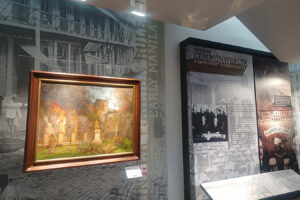IN FEBRUARY 1945, the city of Manila became a bloody battleground between Japanese occupational forces and the returning Americans. For an entire month there were bombardments, street fighting, and massacres and when the smoke finally cleared, 100,000 civilians were dead, and the city was in ruins.
As part of the commemoration of the 80th year since the Battle of Manila, the National Museum of the Philippines (NMP) and the US government, through the American Battle Monuments Commission, opened an exhibit, Liberation of Manila: 80 Years of Remembrance through Art.
Within the peaceful Visitor Center of the Manila American Cemetery and Memorial, where US soldiers who died in battle during World War II now rest in peace, there are four artworks on view by renowned Filipino painters: National Artist Fernando Amorsolo, Diosdado Lorenzo, Nena Saguil, and Galo Ocampo.
These beautifully rendered yet horrific depictions of wartime destruction give context to the monuments honoring those who died, said US Ambassador to the Philippines MaryKay Carlson.
“Art has the power to transcend time, to give voice to the voiceless, to capture history not as cold facts but as lived experience. The four powerful works in this exhibit, created by some of the Philippines’ most celebrated artists, serve as a visual testament to the past,” she said at the exhibit’s opening on Feb. 13.
Ms. Carlson added that the paintings remind people of “shared sacrifices, lives lost, and profound stories that must never be forgotten.” The four pieces were loaned from the NMP’s Fine Arts Collection for this exhibit.
THE PAINTINGSBurning of Sto. Domingo Church (1942) by National Artist Fernando Amorsolo captures the enormous flames that engulfed the centuries-old church for three days in 1941. After the war, the church was relocated from Intramuros to its present site in Quezon City.
“Sto. Domingo Church burned for a long time. When the news of it spread around Manila, Amorsolo went to witness it and then he recorded what he saw through this painting,” NMP Director-General Jeremy Barns told the press during a tour of the exhibit.
Meanwhile, Galo Ocampo turned his attention to a different structure. His work, Ruins of the Legislative Building (1945), illustrates the remains of what was once a Japanese stronghold in the war. Today, the restored Legislative Building in Manila’s Rizal Park stands as the National Museum of Fine Arts.
Diosdado Lorenzo’s Ruins of Sales Street, Quiapo (1946) portrays the destruction of a bustling district, renowned both then and now for its vibrant markets and heritage architecture, while Simplicia “Nena” Saguil’s Ruined Gate of Fort Santiago (1949) is a reminder of the aftermath of intense fighting in the Walled City of Intramuros.
Mr. Barns said that beyond their artistic value, the paintings are “important documentations of war.”
“There are added dimensions and more value to these artifacts,” he explained. “It’s important because, personally, my grandparents were able to tell me a lot about the Japanese occupation and liberation, but I think about the next generation, who won’t have that direct link,” he said.
“It’s important for the National Museum and similar places to pass it on. The course of our country changed. We became independent as a country in ruins, and we’ve been struggling ever since,” he added.
MANILA AMERICAN CEMETERYVicente Lim IV, the Manila American Cemetery and Memorial’s Visitor Center director and the grandson of General Vicente Lim, said that Filipinos are free to roam the cemetery grounds, which are an oasis of trees and fresh air amid the chaos of Bonifacio Global City in Taguig.
“Aside from the peaceful environment, it’s a great way to be in touch with our history,” he told BusinessWorld during a tour of the grounds.
There are 17,000 US soldiers buried in the cemetery, with 3,000 of them unidentified. On the Walls of the Missing are 36,000 names of those whose remains were never found.
“We are the only cemetery that represents the fighting in the Pacific during World War II, which is why we are the biggest of the 26 cemeteries managed by the American Battle Monuments Commission,” Mr. Lim said.
As to why so many American soldiers’ remains are in these grounds, he explained that the soldiers’ families in the US were notified and asked if they would like to repatriate the bodies or if they would allow their dead loved ones to be buried alongside their brothers-in-arms — and 40% agree to the latter.
Those who visit the Manila American Cemetery and Memorial can do so for free. It is open from 9 a.m. to 5 p.m. every day. The Visitor Center welcomes those who have specific inquiries or would like to request a guided tour.
The exhibit runs until Feb. 25 at the Visitor Center of the Manila American Cemetery and Memorial in Bonifacio Global City, Taguig. — Brontë H. Lacsamana
